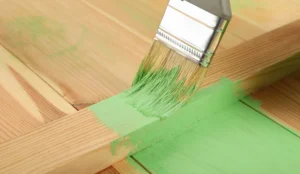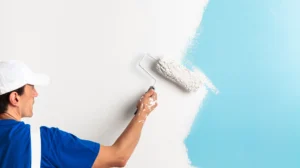
Best Paint for Wood
Painting wood protects it from the elements, from cracking and seals it so it ages well. Depending on if the wood is interior or exterior,
If you remember the strong smell of new paint from your childhood, you may think all paint is supposed to have that smell. However, advances are being made that make paint safer and easier to use, and one such advancement is Low- or No-VOC paint.
VOC is short for volatile organic compounds. These are gasses that are emitted from items like furniture, painted surfaces, new floors and other materials. In a ventilated space or outdoors, these VOCs will disperse with no issues, but in a confined space like a home, high levels of VOCs can cause headaches and other health issues.
Paint cans are now required to be marked by their volume of VOcs ranging from minimal, low, medium, high and very high. While high and very high may be safely used outside since they will disperse in the air, interior paint applications have different considerations.
VOCs inside a home can be 10 times as concentrated as VOCs encountered outdoors. Since people tend to spend lots of time indoors, especially in winter, their level of exposure to VOCs can be very high. That means if you were to paint the interior of your home with a high-VOC paint, you would be breathing in those emissions for at least six months.
Some VOCs emitting from a piece of recently stained furniture can be reduced by storing the furniture in a garage or spare room while it dries. But when you paint a wall, you can’t move the wall outdoors to ventilate it. That leaves you with the option of either constantly airing the room out after a fresh painting or picking a low-VOC paint.
The highest levels of VOC offgassing (the process by which VOCs disperse into the air) occur in the first six months after application. Since it’s not reasonable to paint your house and move out for six months while it cures, people sensitive to VOCs should look for paints that are specifically formulated to reduce offgassing.
These types of paints have many benefits. For starters, the paint won’t have as strong of a smell, so you don’t have to air the room out for days before moving back into it. Low-VOC paints are also thicker, meaning they go on faster, reducing your labor time. They even hold a cleaner edge thanks to their viscosity, so your end result can look more professional.
Low-VOC paint can dry more quickly than regular, so you do need to be strategic when you apply it. Too quick an application can cause the end result to look streaky.
Vista Paint offers several low- and no-VOC paints and primers that are the right choice for interior applications. These options don’t sacrifice quality and will give you the same results as a high-VOC paint.
Primers:
Your primer sets the foundation for your paint. Skimping on primer means your final coat can look uneven, especially if you are painting a light paint over a previously dark coat. Using primer correctly fills in uneven spots and pores, meaning your color will look its best when applied over primer.
Paints:
Choosing the right paint means picking your color and selecting a finish. Ceilings traditionally have a flat finish so they absorb light. Moving into glossy paint will make the paint more light-reflective, but it can also change how color appears. If you’re testing a shine finish and want to paint over it with flat paint, make sure to sand it lightly to get rid of the shine.
Low-or no-VOC paints are the right choice for people concerned with harmful emissions in their homes. If you are looking for low-VOC or no-VOC paints, call your local Vista Paint store.

Painting wood protects it from the elements, from cracking and seals it so it ages well. Depending on if the wood is interior or exterior,

Have you ever tried to paint a home that was covered in incredibly busy wallpaper? (To envision this, think of the décor and wallpaper at

You’ve just been through a big move after spending weeks packing and organizing. However, you won’t be able to feel happy and comfortable in your

Painting wood protects it from the elements, from cracking and seals it so it ages well. Depending on if the wood is interior or exterior,

Have you ever tried to paint a home that was covered in incredibly busy wallpaper? (To envision this, think of the décor and wallpaper at
© 2025 Vista Paint Corporation